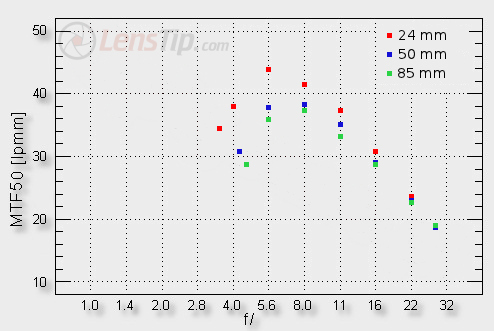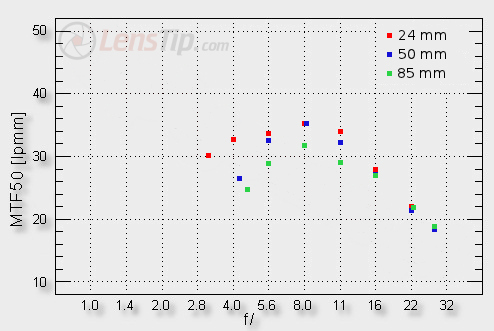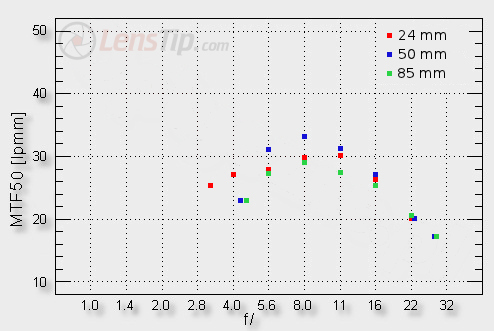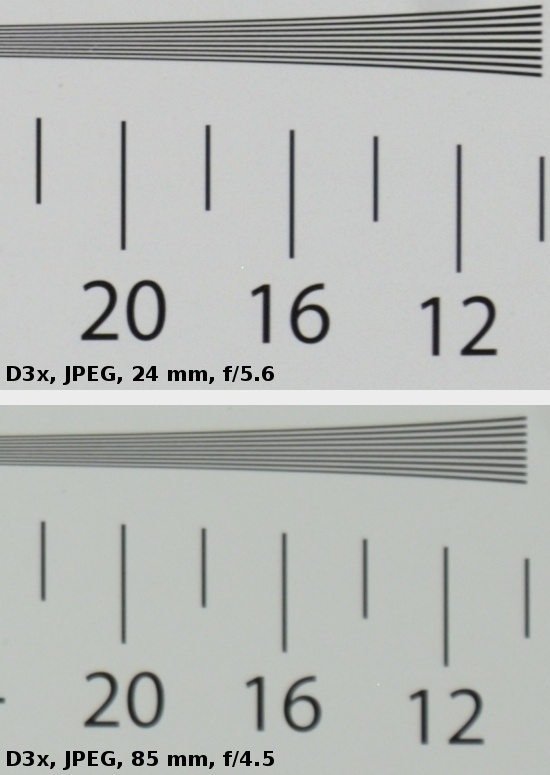Nikon Nikkor AF-S 24-85 mm f/3.5-4.5G ED VR
4. Image resolution
Now let’s see how the lens fares in the frame centre.

At the shortest focal length we don’t have any reservations whatsoever. In its case even at the maximum relative aperture the image is still of good quality. On stopping down the lens is able to get to a very high level of 44 lpmm.
Please Support UsIf you enjoy our reviews and articles, and you want us to continue our work please, support our website by donating through PayPal. The funds are going to be used for paying our editorial team, renting servers, and equipping our testing studio; only that way we will be able to continue providing you interesting content for free. |
- - - - - - - - - - - - - - - - - - - - - - - - - - - - - - - - - - - - - - - - - - - - - - - -
Longer focal lengths are noticeably worse. At the maximum relative aperture the image is on the border of usefulness and to get good results you have to stop the lens down by about 1 EV. What’s worse, even significant stopping down doesn’t make the lens to exceed 40 lpmm. The image is of a good quality but it never reaches an excellent or outstanding level.
A comparison between the Nikkor 24-85 mm VR and the more expensive Nikkor 24-120 mm f/4.0 VR, with a wider focal range, is really interesting. The latter fares noticeably better, showing smaller differences between particular focal lengths and a distinctly better performance near the maximum relative aperture.
Let’s check how the Nikkor 24-85 mm VR fares on the edge of the APS-C/DX sensor.

In this case once again the 24 mm focal length is the best. At the maximum relative aperture you reach the decency level and on stopping down by about 2 EV you can enjoy images of good quality. The 50 mm focal length fares similarly like the 24 mm but only from f/5.6 upwards. At the maximum relative aperture the result is noticeably worse and below the decency level. The maximum focal length fares the worst – a fully useful image can be obtained only near f/8.0.
Although the differences between the Nikkor 24-85 mm VR and its 24-120 mm cousin are here smaller than in the frame centre, that second model fares better once again.
There is only the edge of full frame left – an appropriate graph with the results is shown below.

Unfortunately there are no reasons to be satisfied here– almost none at all. Extreme focal lengths are useful only near f/8.0. The 50 mm focal length fares the best as the useful range is wider, from less than f/5.6 to a bit over f/11. Still, to tell you the truth, these are not results we would like.
At the end of this chapter we present crops taken from our test chart photos, saved as JPEG files.
 |






